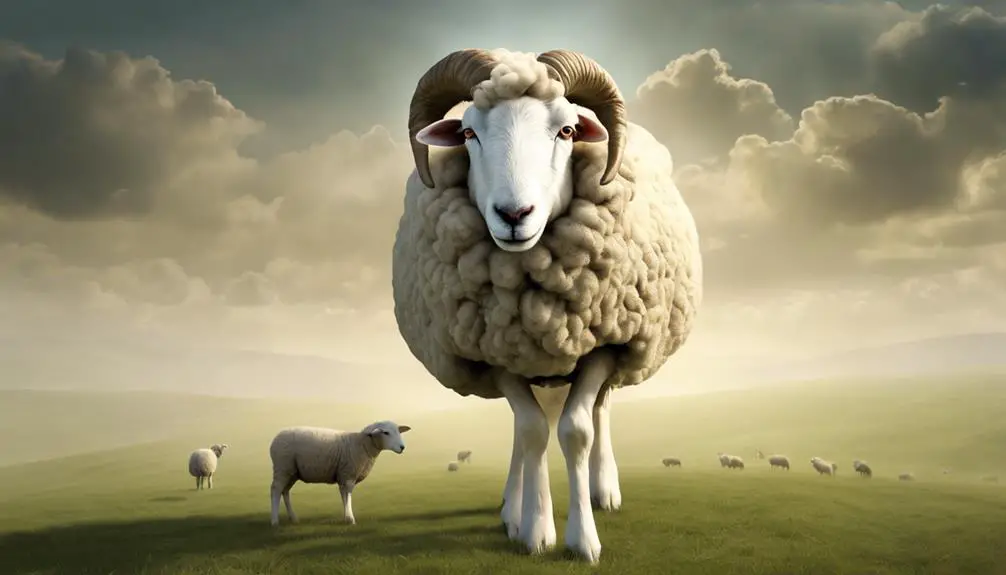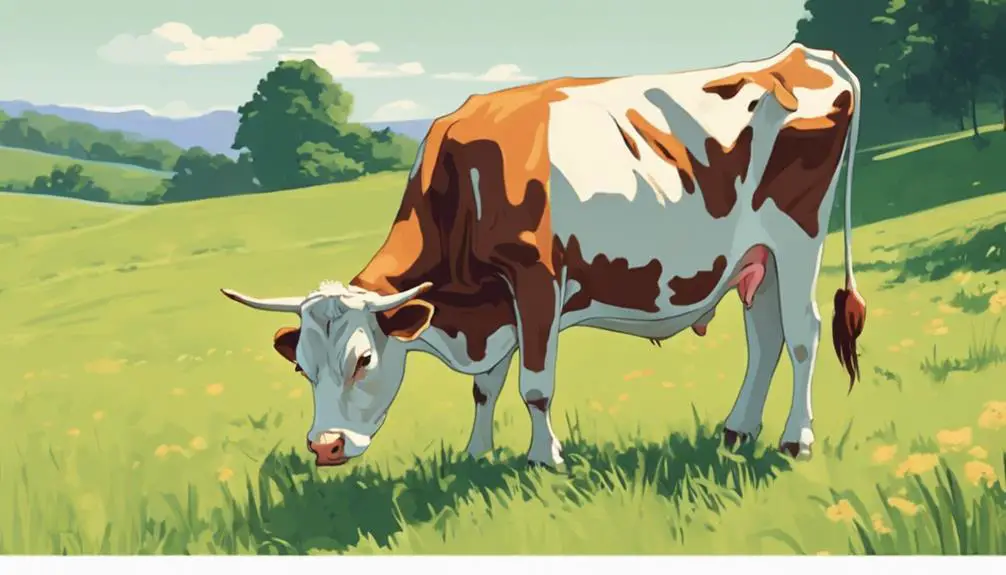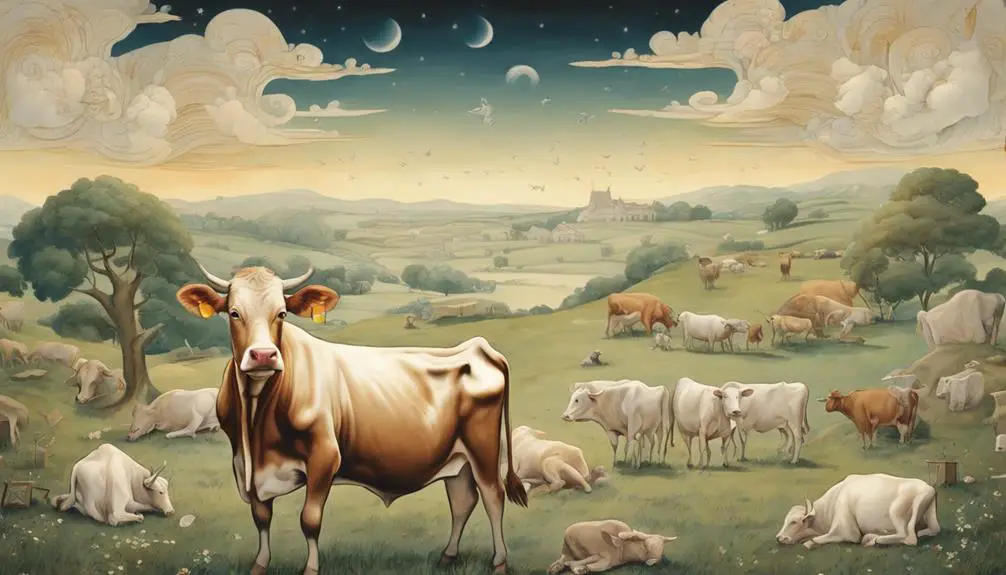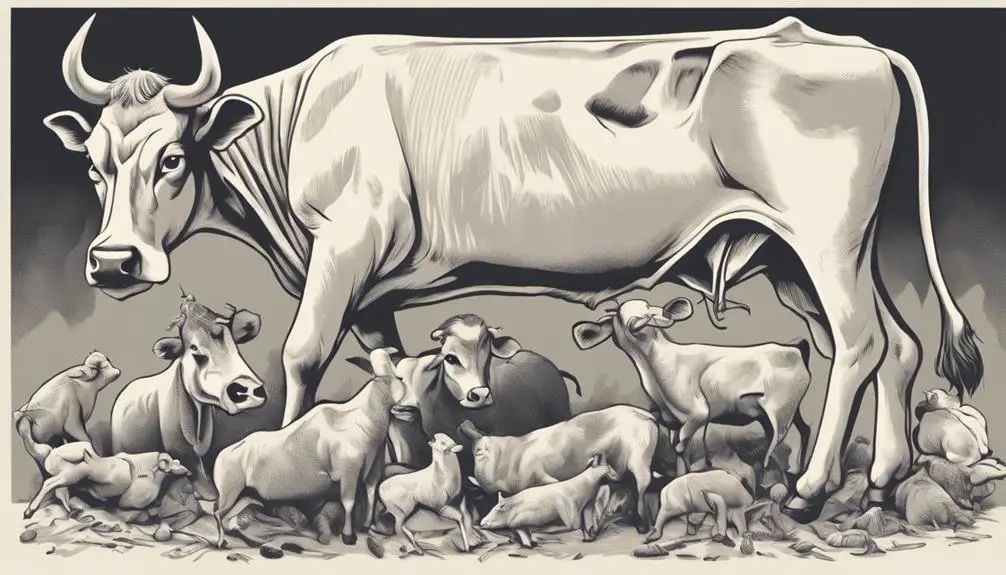A deep dive into the significance of cud in the Bible uncovers layers of spiritual meaning, inviting exploration and reflection.

What Is Cud in the Bible
Just as a cow methodically chews its cud to extract every bit of nutrient, so too can you uncover layers of meaning in the Biblical references to cud. The term itself, often mentioned in the context of dietary laws, points to a deeper understanding of purity, distinction, and divine instruction.
The Bible's dietary rules, specifying which animals are clean or unclean based on their cud-chewing habits, offer more than just ancient health guidelines; they symbolize themes of obedience, holiness, and community. Unpacking these references, you'll find insights into historical beliefs and their enduring impact on modern practices.
This journey promises to reveal how ancient wisdom continues to resonate in today's world, inviting you to explore the rich tapestry of Biblical narrative and its application to contemporary life.
Key Takeaways
- Cud chewing in the Bible symbolizes purity and divine approval through dietary laws.
- It serves as a criterion for distinguishing clean from unclean animals according to biblical standards.
- Cud symbolizes the process of meditation and internalizing spiritual truths in biblical narratives.
- The symbolism of cud encourages believers to engage in spiritual introspection and mindfulness.
Defining Cud and Its Process

What exactly is cud, and how do ruminant animals process it? In the realm of animal digestion, cud plays a pivotal role, particularly for ruminant species. These animals, including cows, sheep, and goats, have a specialized stomach divided into four chambers, facilitating a unique digestive process. Initially, food is consumed and partially broken down in the first chamber, the rumen, before being regurgitated as cud. This regurgitated matter is then chewed again, allowing for further breakdown of the food particles.
This repetitive chewing is crucial as it enhances the breakdown of cellulose, a major component of plant cell walls and a challenging substance for many animals to digest. The saliva produced during this process also plays a significant role, adding enzymes and liquids to aid in digestion. After being chewed thoroughly, the cud proceeds to the other stomach chambers, where it undergoes further fermentation and nutrient absorption.
Understanding this process is essential for comprehending the efficiency of ruminant species in converting plant materials into energy. Their digestive system, capable of breaking down complex plant fibers, sets them apart in the animal kingdom and underscores the adaptability and evolution of animal digestion mechanisms.
Biblical References to Cud

Having explored the biological process of cud chewing in ruminants, we now turn our attention to its significance within biblical texts, where it serves as a criterion for determining clean and unclean animals. The concept of cud is intricately linked with animal digestion, a process that isn't merely physiological but also holds considerable cultural perceptions, especially in the context of ancient Hebrew society.
Biblical references to cud are pivotal in understanding the dietary frameworks and religious practices of the time. These references aren't merely descriptive but are imbued with layers of symbolic and ethical meanings, reflecting a deep intertwining of natural observations with spiritual and moral teachings. The act of cud chewing, as depicted in the Bible, goes beyond a simple biological function; it becomes a metaphor for purity, selectivity, and divine approval.
This emphasis on cud in the biblical narrative highlights the importance of animal digestion in the cultural perceptions of cleanliness and religious observance. It's a testament to how ancient societies used their understanding of the natural world to forge guidelines for communal living, dietary practices, and spiritual purity. Through this lens, cud isn't just a matter of digestive physiology but a symbol deeply embedded in the fabric of biblical law and ethics.
Dietary Laws and Clean Animals

Within the biblical context, dietary laws serve as foundational guidelines for distinguishing between clean and unclean animals, directly impacting the dietary habits and religious practices of ancient Hebrew communities. These distinctions are pivotal, not merely for nutritional or health purposes but for maintaining ritual purity. The classifications of animals according to their cleanliness status are embedded deeply within the fabric of religious observance, reflecting a complex understanding of holiness and the separation from what's considered profane.
The concept of clean animals, notably those that chew the cud and have split hooves, underscores a symbolic framework that extends beyond mere dietary restrictions. It's integral to the communal identity, shaping daily life and spiritual discipline. This categorization system reinforces a boundary that separates the community from surrounding cultures, emphasizing a unique relationship with the divine.
Moreover, the adherence to these dietary laws signifies a form of obedience and respect for divine commandments. It's a tangible expression of faith and a constant reminder of the covenant between the divine and the people. In essence, the dietary laws encapsulate a multifaceted approach to ritual purity, intertwining the physical with the spiritual, and anchoring the community in its sacred traditions.
Historical Interpretations

Exploring the historical interpretations of dietary laws reveals how these regulations have evolved, impacting religious and cultural practices over centuries. The concept of cud, as mentioned in the Bible, serves as a fascinating case study in cultural symbolism and linguistic evolution. Initially, these dietary laws underscored distinctions between clean and unclean animals, deeply influencing societal norms and personal habits.
- Cultural Symbolism: Animals that chew cud were considered clean, symbolizing purity and separation in ancient societies. This distinction wasn't merely dietary but infused with moral and spiritual significance.
- Linguistic Evolution: The term 'cud' has undergone significant transformation, reflecting changes in language, understanding of animal physiology, and religious interpretation. This evolution underscores the dynamic nature of sacred texts and their interpretations.
- Interpretative Variability: Different cultures and religious traditions have interpreted the dietary laws around cud in varied ways, leading to a rich tapestry of practices and beliefs. This variability highlights the intersection between religion, culture, and the natural world.
These historical interpretations offer a window into how religious texts influence and are influenced by the cultural and linguistic contexts in which they exist. They underscore the complex relationship between faith, food, and identity across different epochs.
Modern Implications and Practices

Today's dietary practices and religious observances reflect a nuanced adaptation of ancient laws regarding cud, showcasing the dynamic interplay between tradition and contemporary values. You find that modern interpretations of cud symbolism extend beyond mere dietary restrictions, venturing into the realms of spiritual and ethical consumption. This evolution mirrors a broader societal shift towards introspection and mindfulness in one's daily habits.
Cud, in its biblical context, symbolizes the process of rumination—literally and spiritually. Today, you're encouraged to engage in spiritual digestion, a metaphorical chewing over of teachings and experiences to extract deeper understanding and moral sustenance. This practice resonates with the growing trend of contemplative spirituality, where followers seek to internalize and live out their values more fully.
Furthermore, the consideration of what constitutes 'clean' and 'unclean' in the modern era has expanded to include ethical sourcing and environmental impact, reflecting a holistic approach to purity. You're witnessing a redefinition of cleanliness that aligns with contemporary concerns, yet remains rooted in the essence of ancient wisdom.
In essence, the application of cud symbolism today invites you into a mindful engagement with your beliefs, practices, and the world around you, urging a thoughtful and deliberate approach to life's spiritual and physical nourishments.
Frequently Asked Questions
How Does the Concept of Cud in the Bible Relate to Environmental Stewardship and the Care of Animals in Contemporary Contexts?
In contemporary contexts, the concept of cud, through green theology and animal rights lenses, emphasizes the importance of environmental stewardship and the care of animals. You'll find that this approach encourages sustainable living and ethical treatment of animals, aligning with broader ecological goals.
It's a call to action, urging you to respect and protect the earth's resources and its inhabitants, reflecting a deeper understanding of our interconnectedness with nature.
Are There Any Specific Health Benefits or Risks Associated With Consuming Animals That Chew Cud, According to Modern Nutritional Science?
According to modern nutritional science, consuming animals that chew cud, like cows and sheep, can offer specific health benefits. These animals undergo microbial fermentation in their stomachs, improving digestive efficiency and nutrient absorption. This process can lead to meat that's potentially richer in beneficial fatty acids and nutrients.
However, there's also a risk of transmitting certain diseases from these animals to humans, so it's important to consider both sides.
How Have Different Cultures Around the World Interpreted the Biblical Passages on Cud-Chewing Animals in Their Dietary Traditions?
Different cultures have interpreted biblical passages on cud-chewing animals in diverse ways, leading to various dietary adaptations. You'll find that these cultural interpretations have deep roots in religious beliefs, health perspectives, and environmental considerations.
Some communities see these animals as clean and therefore fit for consumption, while others might avoid them due to differing interpretations. This has shaped dietary traditions around the world, reflecting a fascinating blend of faith, tradition, and nutritional science.
Can the Biblical References to Cud Be Connected to Broader Themes of Purity and Impurity in Other Religious Texts and Traditions?
Certainly, you can link cud symbolism to broader themes of purity and impurity across religious texts and traditions. In interfaith dialogues, examining how cud is perceived offers insights into dietary laws and spiritual cleanliness.
This comparison enriches your understanding of how various beliefs approach the concept of purity, showing that dietary restrictions serve as a reflection of deeper spiritual and ethical principles shared among different faiths.
Has There Been Any Significant Archaeological Evidence Discovered That Provides Insight Into the Ancient Practices of Animal Husbandry and Diet Mentioned in the Bible?
You're exploring if archaeological discoveries shed light on biblical animal husbandry and diet practices.
Indeed, findings like ancient cookware have provided clues. These artifacts, alongside dietary laws inscribed in texts, help us understand the historical context of food preparation and consumption.
Scholars analyze these pieces to piece together the dietary habits mentioned in the Bible, offering a tangible connection to the ancient world and its complex views on purity and impurity.
Conclusion
In conclusion, you've explored the concept of cud within a biblical context, examining its definition, references, and implications on dietary laws.
Historical interpretations have shown a deep intertwining of religious texts and dietary practices, highlighting the importance of clean animals in these traditions.
Modern practices continue to reflect these ancient guidelines, showcasing the enduring influence of biblical dietary laws on contemporary religious communities.
Your understanding of cud, therefore, bridges ancient wisdom with modern faithfulness, encapsulating a tradition that spans millennia.



Sign up